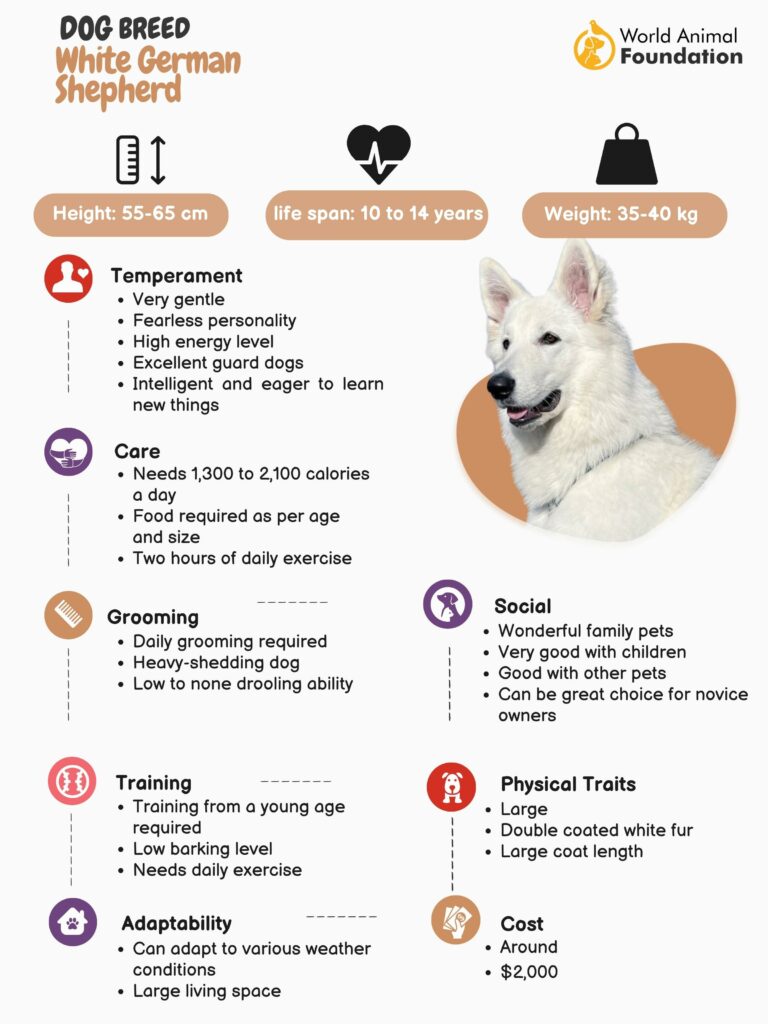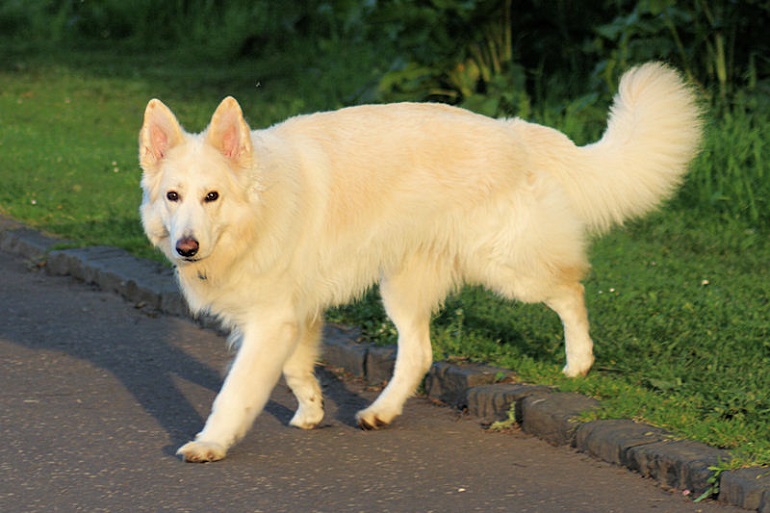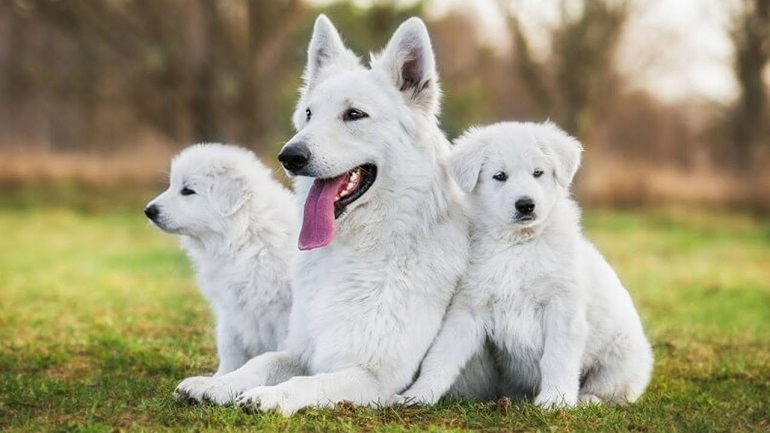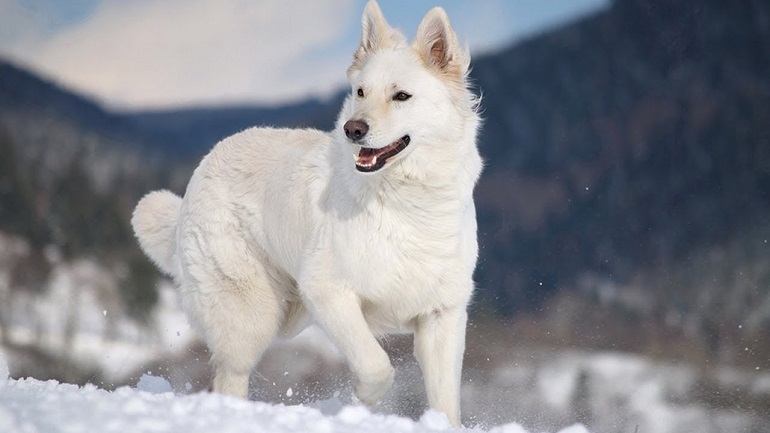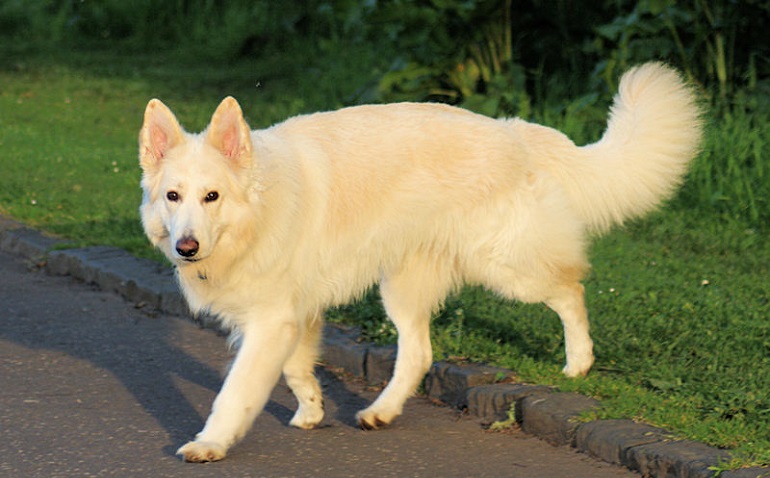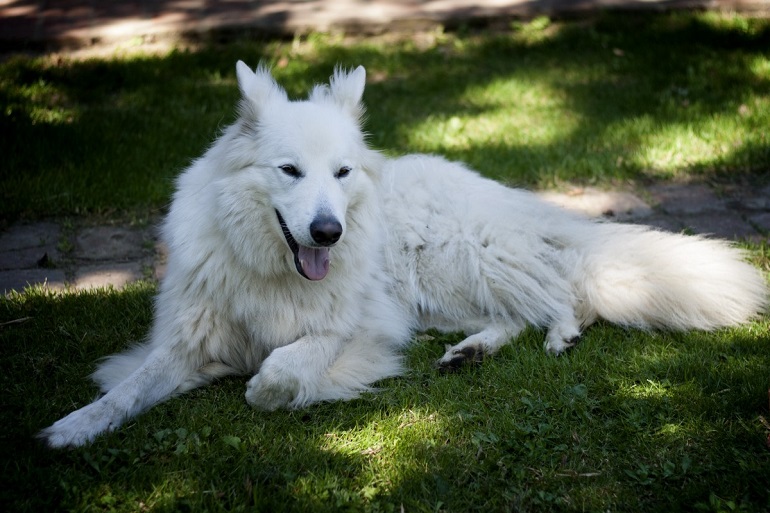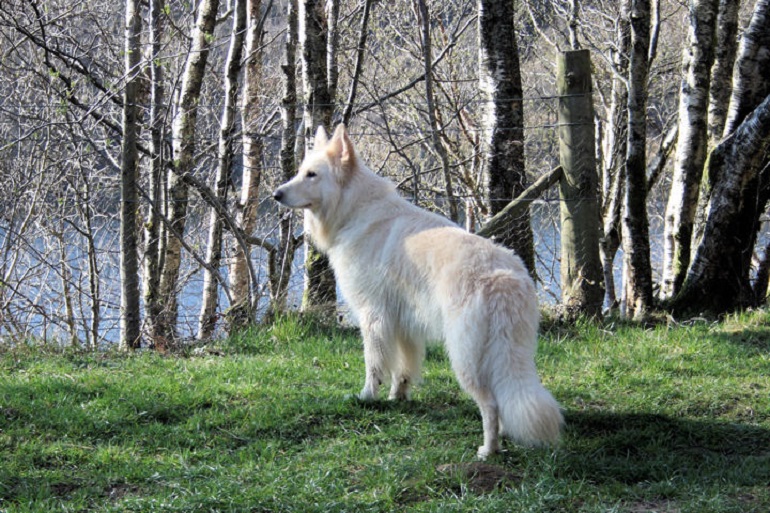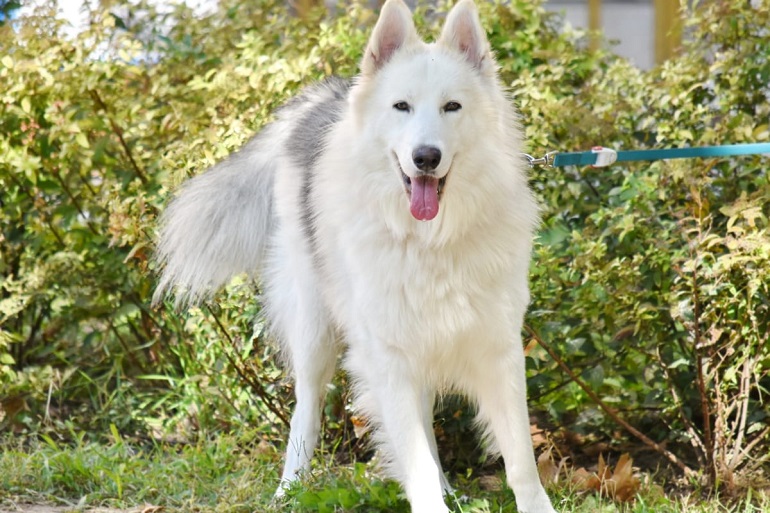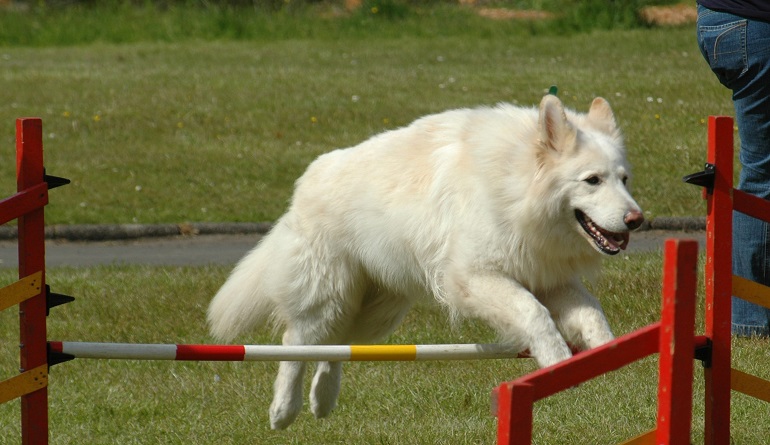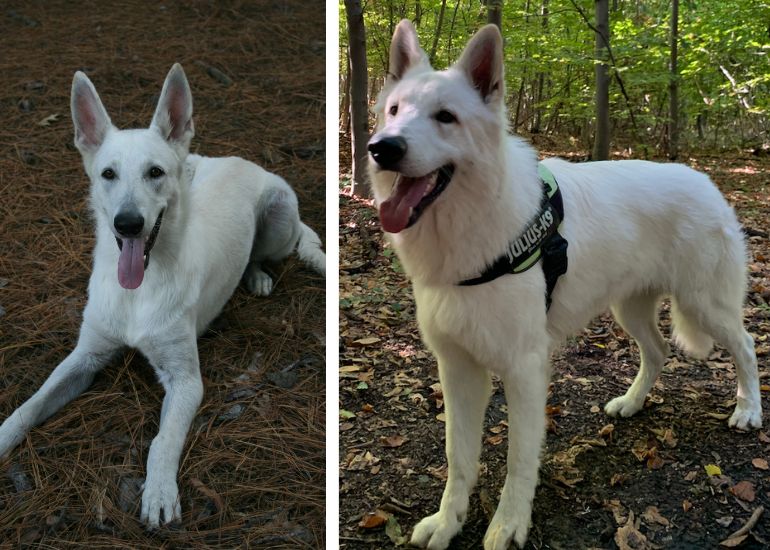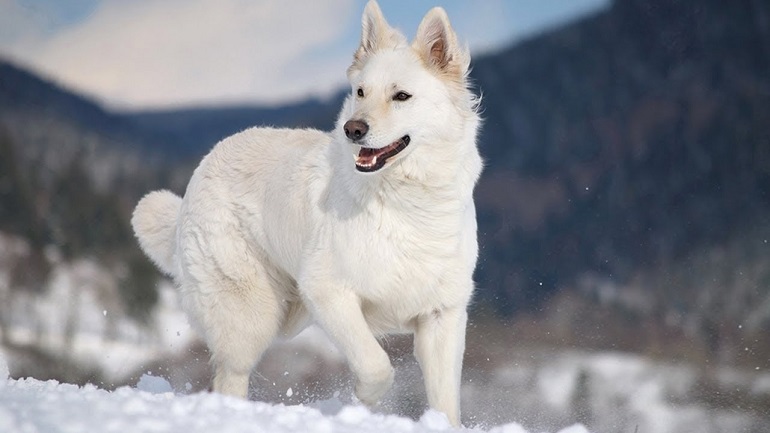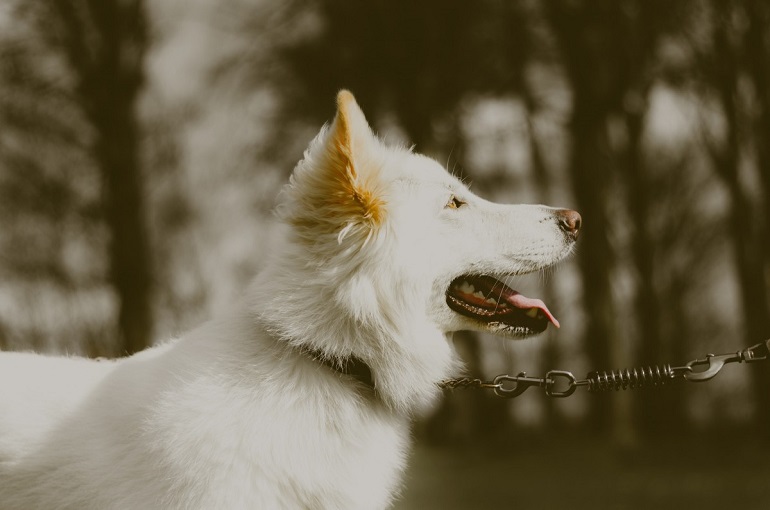The White German Shepherd, often mistaken for an albino, is a striking variant of the popular German Shepherd breed. Possessing the same intelligence and loyalty, their brilliant white coat sets them apart. This comprehensive guide delves into everything you need to know about these magnificent dogs, from their unique genetic makeup and specific care requirements to fascinating facts and captivating pictures. Discover if a White German Shepherd is the right companion for your active lifestyle and loving home.
White German shepherds are a magnificent breed. They are one of the most intelligent breeds and have a loyalty to their family that is nearly unparalleled.
Although officially regarded as a separate breed from their more recognizable cousins, they are otherwise genetically identical.
I grew up surrounded by German shepherds. My grandparents had brown and tan shepherds my entire life. I have entire photo albums filled with only pictures of their dogs and me over the years. They were gentle creatures and loving beyond measure.
In fact, one of their German shepherds was from the Makabusi Otto lineage.
Let’s take a closer look at this rare breed of dog.
About the Breed
The White German Shepherd is a separate breed of shepherd dog recognized by the United Kennel Club. They are medium to large dogs that can grow to 25 inches and weigh approximately 40 pounds.
White German Shepherds are super smart and very energetic dogs. They love mental and physical stimulation stemming from their origins as working dogs.
History of the White German Shepherd
The history of the White Shepherd dog dates back to Germanic areas of Europe. The shepherd breed originated from sheep fields, where powerful herding dogs were needed.
However, white-coated dogs proved to be ineffective as herders because they blended in with the sheep.
This led to a major change being made in 1933. Germany altered the breed standard, banning the recognition of the white Shepherd as part of the German shepherd breed. It took until 1969 before the white shepherd dog became a registered breed in its own right.
While there are no genetic differences between the white and regular German shepherds, the white Shepherd is regarded as a separate breed by the United Kennel Club.
White German Shepherd Facts
Below are ten interesting facts about the White Shepherd.
1) White shepherds are recognized as a separate breed by the United Kennel Club despite having no genetic differences from tan and black shepherds.
2) Female white shepherd dogs are smaller and more docile than males.
3) Their white fur comes thanks to them having a recessive gene for white hair.
4) White German shepherds are great family companions.
5) A White Shepherd dog requires at least two hours of exercise daily.
6) In 2021, the German shepherd breed was the fourth most registered breed, according to the American Kennel Club. White German Shepherds are counted as part of this breed despite having a separate breed standard in the United Kennel Club.
7) In 1933, Germany changed the breed standard to exclude the white color dog explicitly.
8) Despite popular myths, no German Shepherd breeds have wolf ancestors.
9) While they have a mild temperament, White Shepherds must be exposed to proper socialization so as not to become jealous or aggressive toward strangers.
10) Hip and elbow dysplasia are two of this breed’s most common health problems
White German Shepherd Appearance
White German Shepherds are medium to large dogs with muscular frames and a white coat color. While most White German Shepherds have short fur, some have long coats.
The average height of White German shepherds is 25 inches for males. They are not the best dogs for you if you live in a small apartment.
Unlike albino dogs, White German Shepherds have brown or gold eyes and pink skin, the same as other dogs.
What Are the Characteristics of the White German Shepherd Dog
White German Shepherd dogs are a wonderful breed with four key characteristics.
- Loyalty: German shepherds are an extremely loyal breed. The White Shepherd is a family dog and builds close bonds with their family unit.
- Intelligence: White German Shepherds are highly intelligent dogs and enjoy being mentally stimulated. The entire German Shepherd dog breed is renowned for excelling at obedience training.
- Protectiveness: The White Shepherd is highly protective of its family and surroundings. Excellent guard dogs; they will bark and alert you whenever they sense a threat.
- Hard Working: German Shepherd dogs are hard-working, which, combined with their intelligence, protective nature, and loyalty, makes them perfect for jobs that require focus and dedication.
What Is the Average Size of a White German Shepherd?
The average size of a White German Shepherd is 60-65cm for a male and 55-60 for a female. German Shepherd dogs are generally classed as medium or large dog breeds.
How Much Does a White Shepherd Weigh?
The average weight of a White Shepherd dog is around 35kg for females and up to 40kg for males. A muscular dog, the White German Shepherd needs plenty of exercise.
However, they should not be allowed to get fat due to joint problems that are common in this breed.
What Is the Coat of a White Shepherd Dog Like?
The White Shepherd dog coat is a weather-resistant straight double coat. They can be short or long-haired, depending on their breeding.
A shedding dog, shepherds need a lot of grooming to prevent their coat from becoming matted. This becomes more necessary during the shedding season.
Is a White German Shepherd Really Just White?
Yes, a White Shepherd is an all-white dog breed. However, it can also be found with a light cream or nude coat. It is important not to confuse White German shepherds with albino German shepherds. The striking beauty of these dogs has inspired a range of German Shepherd shirts, celebrating their unique and captivating appearance.
What Is the Lifespan of a White German Shepherd?
A White German Shepherd’s average lifespan is between 10 and 14 years. As larger dogs, they tend to have a shorter lifespan than other breeds.
Interestingly, the life expectancy of the female White German Shepherd dog is longer than the male.
Things To Know When Owning a White German Shepherd
Owning a dog is a big responsibility. Before picking up your White German Shepherd puppy, here are some important things for prospective German Shepherd dog owners to understand about their breed.
Food & Diet Requirements
Much like humans, dogs have a calorific need that should be met with the best dog food for optimum health and well-being. White German Shepherds should aim to eat between 1,300 to 2,100 calories a day, depending on the activity level.
Within that, they should eat a balanced mix of protein, fat, and fiber. In addition, carbohydrates, vitamins, and water intake should also be regulated.
- Fat: Adults need around 5% of their calories from fat. White German Shepherd puppies need about 8-10%.
- Protein: Adults need around 18% of their calories from protein. Puppies need approximately 22% of their caloric intake from protein.
- Fiber: Adult shepherds need approximately 3% fiber, while puppies should have around 7%.
Exercise
Herding dogs, the White German Shepherd is a high-energy dog and needs at least 2 hours of exercise every day. Great exercises for a German Shepherd include:
- Daily walks
- Hiking
- Swimming
- Fetch or frisbee
- Hiding treats for your dog to find.
- Obedience training
Grooming
The White German Shepherd is a heavy-shedding dog with a double white coat and requires regular brushing. Ideally, a White Shepherd should be groomed every other day, possibly daily, during the peak shedding season.
Male vs. Female
While for many animal species, the female is larger, with the German Shepherd, it is the males that are larger. The males’ heads are also broader, while they have a more powerful and thicker physique.
While German Shepherds are all loyal and loving family dogs, it is often noted that females are more docile than males. This makes a female Shepherd a better choice for homes with young children.
A female White Shepherd reaches sexual maturity at two years of age and has a litter of between five to ten puppies.
White German Shepherd Temperament and Personality
Many believe that the White German Shepherd has a gentler temperament than the standard Shepherd. They have an intelligent and fearless personality and are eager to learn and please. These traits make them wonderful family pets.
A determined personality also makes shepherds adept at being working dogs. With their ability to learn and eagerness to work, it’s easy to see why this breed is so often employed by law enforcement.
The White German Shepherd is a loyal and loving dog that quickly forms an unshakable bond with its family and is fiercely protective of them.
It is vital for all dog owners to understand that training is important. Any German Shepherd breed needs to be trained and socialized correctly. Failing to do so leads to problems with jealousy and distrust of strangers.
White German Shepherd Health and Care
All dogs come with their own potential health problems and care requirements. For the White German Shepherd, there are several critical quality-of-life considerations to make.
While both White and regular German Shepherds suffer from a lot of the same health issues, there are some with a higher prevalence in white breeds.
Hip Dysplasia
Hip dysplasia is one of the most common health issues faced by White German Shepherd dogs. Caused by a misformation of the hip joint, dysplasia is a painful condition resulting from bone-on-bone grinding.
While it can be seen in White German Shepherd puppies as young as four months, it is more common in older dogs. It can be treated with the help of CBD Oil for hip dysplasia.
Arthritis
Did you know that 80% of older dogs suffer from arthritis? Sadly, this painful condition is very prominent in German shepherds. This is largely due to their combined size and energy levels.
Unfortunately, arthritis is a progressive condition that cannot be cured. However, if the right steps are taken to regulate your dog’s diet and exercise, it can be managed as best as possible.
In the White GSD, arthritis is more common in their hind legs than in their front.
Gastric Bloat
Gastric bloat is the common name for a serious medical complaint known as gastric dilatation volvulus (GDV). Bloat commonly occurs in larger dogs, particularly German Shepherd breeds.
Gastric bloat is when the dog’s stomach gets twisted, blocking the passage of food into and out of the stomach. There is no time to waste with this condition. If a dog is showing signs of bloat, they need immediate medical attention, as it could quickly become fatal.
Canine Degenerative Myelopathy (CDM)
Canine degenerative myelopathy is a degenerative disease that affects the spinal column. German Shepherds are one of the most commonly affected breeds. The result of CDM is commonly rear-leg paralysis.
Middle-aged dogs between 4 and 14 years old are more likely to be diagnosed with CDM. Pay attention to any limping or signs of motion impingement.
Other Diseases
Deafness is another disease that is more common for the White German Shepherd than other breeds. As a general rule, deafness is a common health concern for white-coated dogs and other animals.
Many people don’t realize, but German Shepherds and other dogs can also suffer from allergies much the same as many people. Some of the core allergies that affect this breed are related to chicken, wheat, and dairy.
Dental decay is also a serious problem that is frequently observed in German Shepherds. More so with them than many other breeds. Therefore, it’s important to make sure your dog’s teeth are well maintained. Using dental chews in combination with a healthy diet is a great way to promote healthy teeth and gums.
Although, a few yummy treats now and then won’t go amiss.
White German Shepherd Training
White German Shepherds are intelligent and respond well to training. They love to be challenged, while their loyalty sees them eager to please. While Shepherds make great pets, it is important to train them from a young age.
Below are five training tips for White German Shepherds.
- Be consistent: White and other German Shepherds all respond better to training when there is consistency to things. Everything from your manner to the commands you use needs to be consistent from one training session to another.
- Iterative steps: Don’t expect your white puppies to pick up everything straight away. Layer your training in easy-to-iterate steps. Master one of two commands before introducing something else.
- Be a leader: It is important to remember that dogs are looking for you to be a leader and not a dominator. You must be prepared to take charge rather than use aggression as a training tactic.
- Communicate properly: Dogs do not communicate the same way humans do. It is important to understand the right way to communicate with your White Shepherd. Short and clear commands yield the best results. Also, avoid using similar-sounding commands, as these are likely to confuse your dog.
- Practice positive reinforcement: Never punish a dog for not doing well in training or for struggling to recognize a command. Instead, positive reinforcement is the recommended training practice. Reward your furry friend for every good deed.
How Much Do White German Shepherds Cost?
You should expect to pay around $2,000 minimum for one of these stunning white-coated dogs. However, the exact costs will vary depending on where you are and the size of the litter.
The price also relates to buying White Shepherd puppies from a recognized breeder and not from a puppy farm or through shelter adoption.
White German Shepherd: Are they distinct from other German Shepherds?
White German Shepherds are different from other German Shepherd dogs in so far as they have a white coat rather than the traditional tan and brown.
However, genetically, there is no difference between White Shepherds and other shepherds. The difference between them is that the White German Shepherd carries a recessive white gene that changes its fur color. This is the same way some humans are born with blond hair.
Conclusion
The White German Shepherd is the rare form of one of the most easily recognized dogs in the world. Wonderful family dogs. German Shepherds love to be part of the family. They struggle when home alone for long periods. Luckily, this breed is very good with children.
The same as any other dog, White Shepherds need to be trained. Exercise is also crucial for this breed, as they can become destructive if they do not get enough physical and mental stimulation.
If you work from home or have a family member at home a lot of the day, then a White German Shepherd is an ideal dog. Just make sure ahead of time that you understand the amount of work it takes to train a shepherd puppy from a young age.
Whether you are a new or experienced dog owner, the White Shepherd is a great choice for your house.
All dogs need love and affection, but the hyper-intelligent German Shepherd needs more than most in order for them to truly feel settled in their home. Luckily, the effort you put in is returned multiple folds in the affection your dog shows.
Related Guide:
- Australian Shepherd
- English bulldog
The White German Shepherd, while visually striking, is essentially a German Shepherd with a recessive gene. They share the breed’s intelligence, loyalty, and energetic nature, requiring consistent training and plenty of exercise. Potential owners should be prepared for a commitment to grooming to maintain their pristine white coat. While prone to some health issues common to German Shepherds, responsible breeding practices and proper care can ensure a long and happy life for these beautiful companions. Ultimately, the White German Shepherd offers a unique aesthetic combined with the beloved temperament of the breed.


